Herons are tall, charismatic birds that grace aquatic habitats across the state of Texas. Avid bird watchers understand that herons bring messages of progress and self-determination, making them extraordinary creatures for those who believe in luck. Discover the 12 types of herons in Texas, how to identify them, and their habitats.

1. Great Blue Heron

The
great blue heron
lives year-round in Texas, inhabiting marshes and swamps.
©Brian Lasenby/Shutterstock.com
The great blue heron is the largest and most common heron in North America, with long legs, an “S” shaped neck, and a bushy appearance. Their overall color is bluish gray, with a broad black stripe over their eyes. This heron has an abundant and widespread population in Texas, with significant concentrations in Central and East Texas around the coast.
The great blue heron is associated with water but lives in various habitats, like marshes, swamps, estuaries, meadows, seashores, and artificial habitats like reservoirs. It lives year-round in Texas; you can often see it standing silently in bodies of water or flying overhead with slow wingbeats. Their habitats and diet are highly variable, and they can quickly adapt to thrive in any geographic location. They eat mainly fish but will also consume salamanders, turtles, frogs, snakes, and other birds.
2. Black-Crowned Night Heron

The black-crowned night heron has white feathers on its breast along with greyish black wings.
©Nycticorax nycticorax/Shutterstock.com
This heron is light gray with a black cap and back. It appears stalkier than the great blue heron and almost passive in how it stands hunched over near the water’s edge. As its name suggests, these birds become active at dusk and begin feeding in the dark; you will often hear their loud barking calls as they fly overhead in the darkness.
You can find the black-crowned night heron in Texas year-round, predominantly near the Gulf Coast. However, there is a chance to see them in the Panhandle during the breeding season. They roost in trees near aquatic habitats like marshes, seashores, rivers, and swamps. This night heron dines on fish, insects, frogs, squid, carrion, rodents, and may occasionally eat eggs and birds, creating problems within colonies.
3. Green Heron

Green herons have chestnut brown necks decorated by a vertical white line.
©Gerry Matthews/Shutterstock.com
The green heron has a bluish-green iridescent back and mohawk-style feathers on its crown with a reddish-brown neck. It’s a relatively small heron that prefers solitary habitats around small ponds and lakes with heavy vegetation. You can find this bird year-round along the Gulf Coast and parts of Central and East Texas during the breeding season.
It’s a somewhat nervous bird, often seen flicking its tail when spotted by humans. You may hear it before you see it as it zips past you, making its sharp “skyow!” call. You rarely see the green heron in large groups, only small, isolated pairs or groups during nesting season. Like other herons, they mainly eat fish, crustaceans, aquatic insects, and frogs.
4. Great Egret
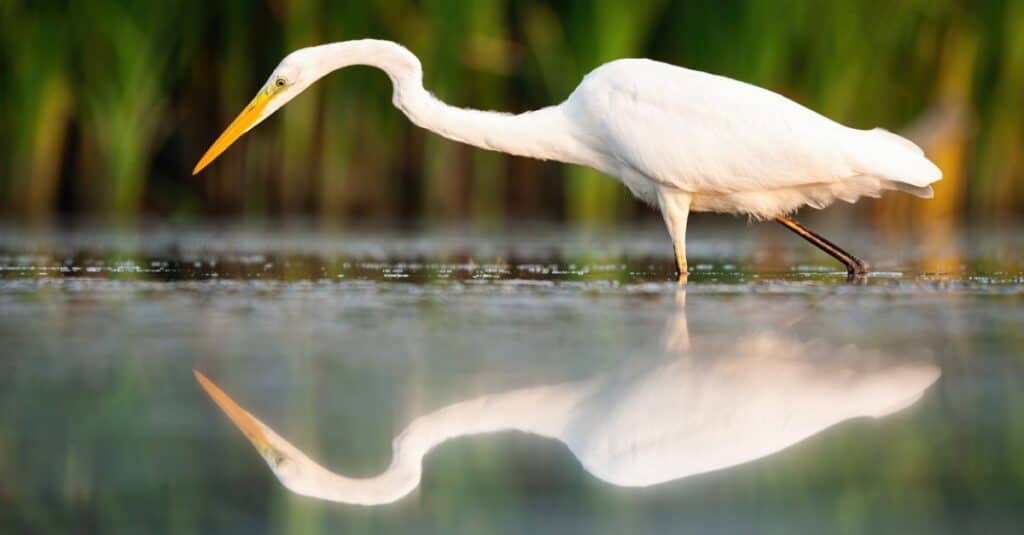
The great egret lives near the Gulf Coast and the eastern half of Texas.
©WildMedia/Shutterstock.com
The great egret is a tall snow-white heron with bright green circles around its eyes. It likes to wade in peaceful water in Southern states, especially near the coastline. You will find this stately bird year-round near the Gulf Coast and the eastern half of the state during the breeding season. On occasion, you may witness the great egret near the border of Mexico in the winter.
These birds forage near the edges of lakes, marshes, and coastal lagoons, eating mainly fish. It may be in flocks near the water’s edge or on its own near cattle in fields. However, it may also venture to open areas where it hunts for rodents, grasshoppers, and small birds.
5. Cattle Egret

The cattle egret breeds in South and East Texas.
©Richard A McMillin/Shutterstock.com
The cattle egret is strongly migratory and has an incredible range. It inhabits the Gulf Coast year-round, but you can also view it in the southern and eastern parts of the state during the breeding season. It’s also common for them to migrate through the rest of the state, mainly western regions and the Panhandle.
This bird is all white except for patches of yellow on its breast, back, and crown. Unlike most herons and egrets, this species prefers to forage for insects in open fields. It will follow cattle or other grazing animals and wait for them to bring bugs into view, particularly grasshoppers and crickets. You will often find the cattle egret on farms, pastures, or any open country with grazing animals nearby.
6. Snowy Egret
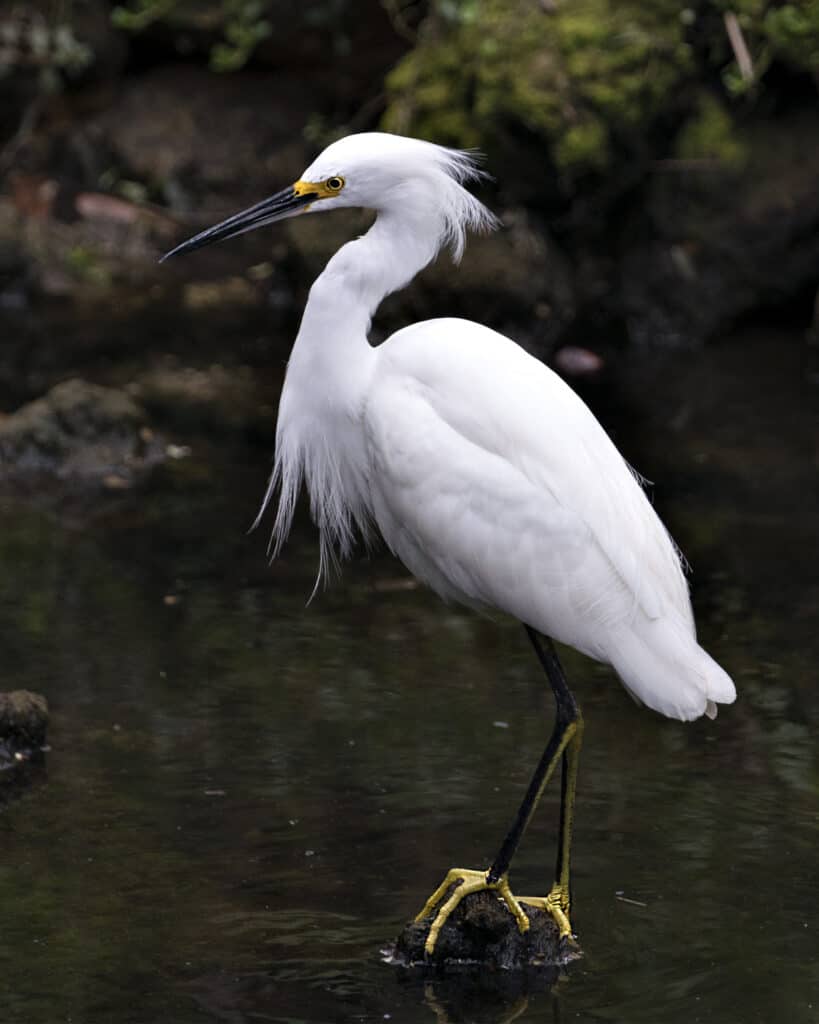
The snowy egret lives on the Gulf Coast year-round.
©iStock.com/Rejean Bedard
This small, delicate heron is all white, except for a patch of bright yellow below its eyes. Its graceful appearance is awkwardly interrupted by its harsh squeaks and gagging croaks. Its yellow feet dance above the water as it actively looks for its prey in the shallow areas.
This heron lives year-round in the Gulf Coast region and the far eastern half of the state near the Louisiana border during the breeding season. It lives in fresh and saltwater habitats, including marshes, swamps, bays, and shores. It walks or runs in shallow water, preying on fish, insects, crustaceans, frogs, snakes, lizards, and rodents.
7. American Bittern

The American bittern lives in extensive freshwater marshes near the Gulf Coast during winter.
©iStock.com/Marianne Pfeil
The American bittern has varying shades of streaky brown with white on its underbelly and yellow under its eyes. It’s a migratory bird with only a few spots on the West Coast it stays year-round. In Texas, you will find this heron near the Gulf Coast in winter and the rest of the state during its migration.
This large bird is solitary and prefers to live in extensive freshwater marshes, except during winter when it occasionally settles in the salty water of coastal wetlands. Its diet consists of catfish, eels, frogs, crabs, snakes, and insects. It stands still and waits for its prey by the water’s edge, then suddenly thrusts its bill into the water to catch its aquatic dinner.
8. Least Bittern
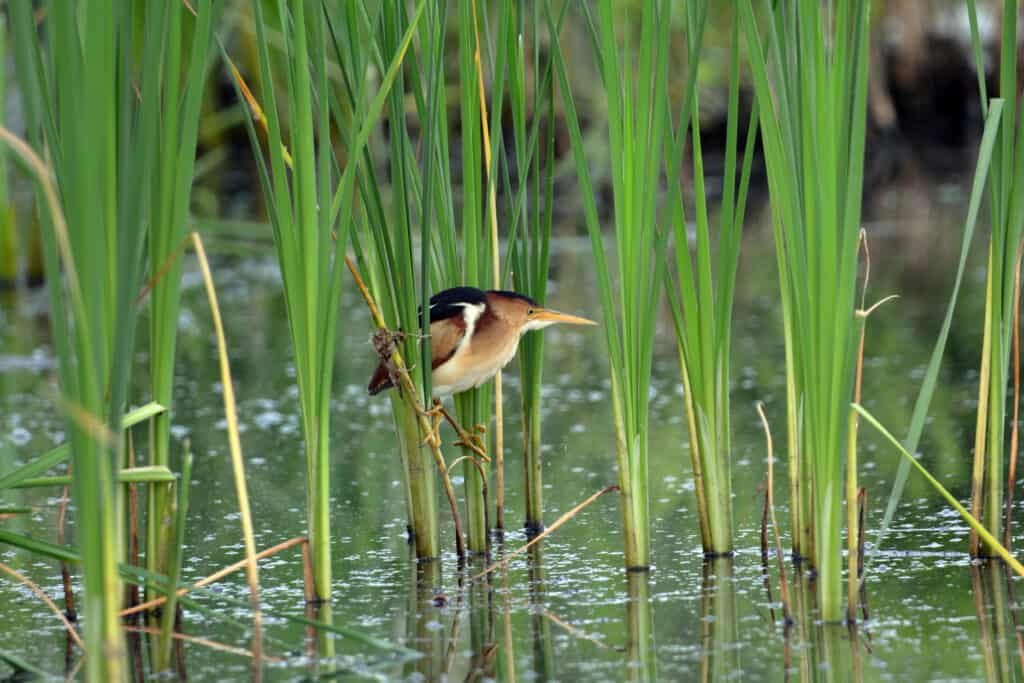
You can find the least bittern in East Texas during the breeding season.
©iStock.com/Carol Hamilton
The least bittern is one of the smallest herons in the world and is easily overlooked in the dense vegetation of its marshy home. It is light to medium brown with a black back and crown, a white underbelly, and a yellow bill.
While this species isn’t a year-round Texas resident, you can find them in the Gulf Coast region and the far eastern half of the state during the breeding season. They also migrate through the Panhandle, Central, and West Texas. However, it may be hard to spot them as they fly at night. They mainly inhabit fresh marshes with tall and dense vegetation, where they cling to reeds and jabs their beaks into the water. They eat a similar diet to other herons, just in a more diminutive form: minnows, tadpoles, and small snakes.
9. Yellow-Crowned Night Heron
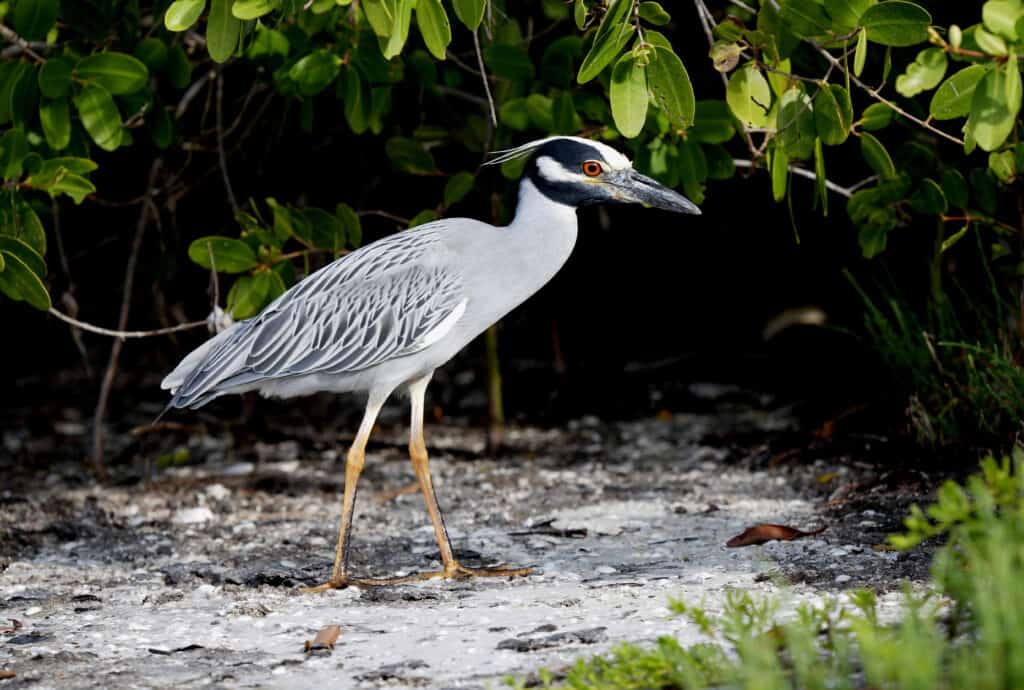
The yellow-crowned night heron inhabits the southern tip of Texas year-round.
©iStock.com/neil bowman
The yellow-crowned night heron is all black or gray except for white stripes on the sides of its face and light-yellow tufts of fur on its forehead. This solitary bird inhabits the southern tip of Texas year-round and the far eastern half of the state near Louisiana during the breeding season.
It prefers to dwell in cypress swamps, mangroves, bayous, and shallow tidal waters, where it forages for food by slowly walking in shallow water. It’s a pickier eater than other herons and feeds heavily on crustaceans, like crabs and crayfish. Nicknamed the “crab eater,” it was introduced to Bermuda to tame their land crab population.
10. Little Blue Heron
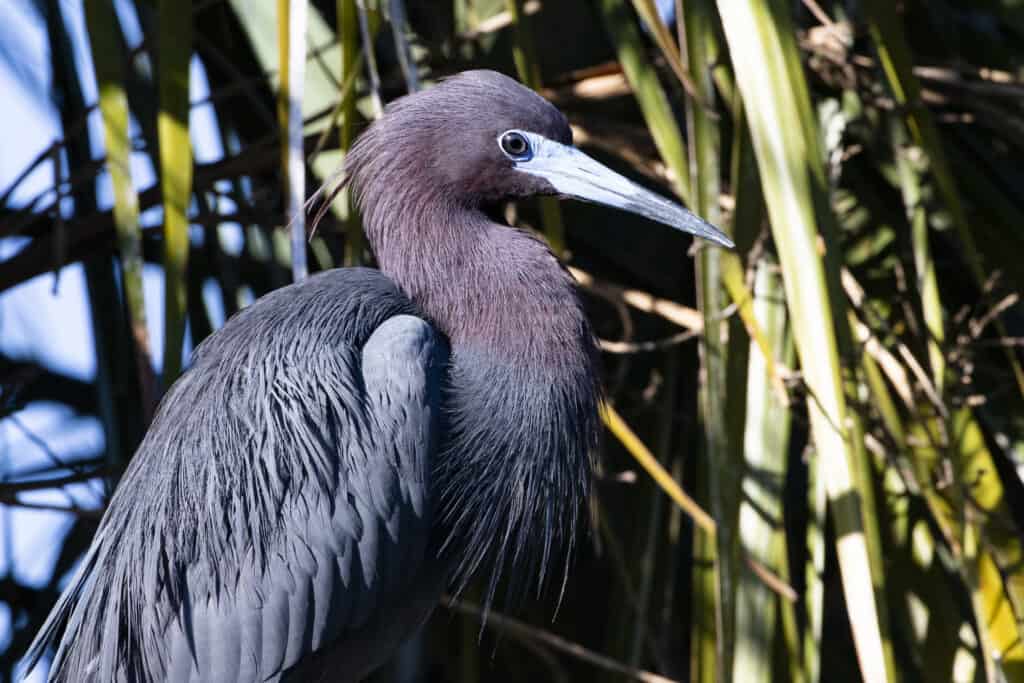
The little blue heron lives along the coast in marshes and swamps.
©iStock.com/Florence and Joseph McGinn
The little blue heron resembles more of an egret than the great blue heron. This little heron is dark blue overall with a lighter blue beak and greenish-colored legs. You can find this species year-round along the Texas coast and the far east near Louisiana during the breeding season.
The little blue heron is typically silent and will only squawk when alarmed. It nests in trees or thickets near marshes, ponds, rice fields, swamps, and shores, where it slowly forages in shallow water or on beaches. It eats a variable diet of fish, crustaceans, insects, frogs, lizards, snakes, and spiders.
11. Tricolored Heron
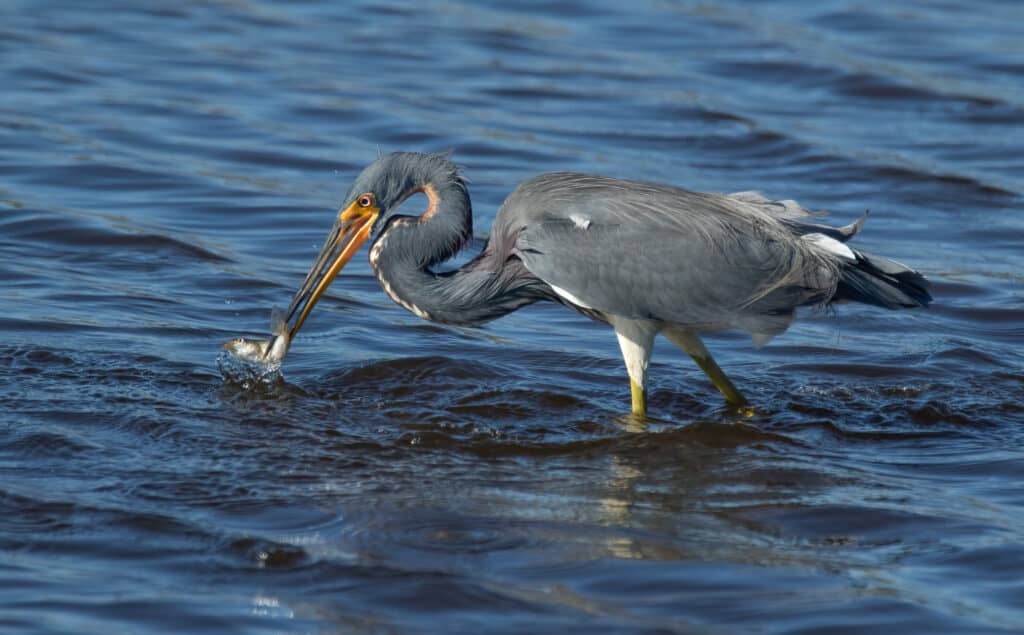
You can find the tricolored heron belly-deep in coastal lagoons.
©iStock.com/MattCuda
The tricolored heron is dark bluish gray on top and a light gray or white on the bottom with yellow feet and an orangish beak. You can find this heron year-round along the Texas coastline near marshes, swamps, and shores; it’s often belly-deep in the waters of coastal lagoons. This slender bird has long extremities and is typically sociable when nesting but solitary when feeding. It keeps small feeding territories as it slowly walks through shallow water, eating mainly fish, crustaceans, and insects.
12. Reddish Egret

You can find the reddish egret on brush-covered islands off the Texas coast.
©iStock.com/Donyanedomam
The reddish egret has long legs and a long neck with multi-colored plumage. Its head and neck are reddish-brown, while its bottom half is a dark gray. However, this bird has two color morphs; the other morph is all white. Its beak is also multi-colored, with blue around the eyes transitioning to purple, pink, and black.
You will find this heron along the coastal areas in Texas year-round. This species prefers saltwater more than any other heron, and you can frequently spot it on islands covered in brush in the Lone Star state. It also inhabits coastal tidal flats, salt marshes, and lagoons. This unusual bird is active when it feeds, running through shallow waters and leaping in the air to stab fish, its primary food source.
Summary of 12 Types of Herons in Texas
| Name | Habitat | Diet |
|---|---|---|
| Great Blue Heron | Marshes, swamps, estuaries, meadows, seashores, and reservoirs. | Mainly fish, but also salamanders, turtles, frogs, snakes, and other birds. |
| Black-Crowned Night Heron | Roost in trees near aquatic habitats like marshes, seashores, rivers, and swamps. | Fish, insects, squid, carrion, rodents, frogs, and sometimes eggs and birds. |
| Green Heron | Solitary habitats around small ponds and lakes with heavy vegetation. | Fish, crustaceans, aquatic insects, and frogs. |
| Great Egret | Edges of lakes, marshes, and coastal lagoons or open areas. | Fish, rodents, grasshoppers, and small birds. |
| Cattle Egret | Farms or pastures with grazing livestock. | Bugs, particularly grasshoppers and crickets. |
| Snowy Egret | Fresh and saltwater habitats, including marshes, swamps, bays, and shores. | Fish, insects, crustaceans, frogs, snakes, lizards, and rodents. |
| American Bittern | Extensive freshwater marshes; in winter, in the salty water of coastal wetlands. | Catfish, eels, frogs, crabs, snakes, and insects. |
| Least Bittern | Fresh marshes with tall and dense vegetation. | Minnows, tadpoles, and small snakes. |
| Yellow-Crowned Night Heron | Cypress swamps, mangroves, bayous, and shallow tidal waters. | Crustaceans, like crabs and crayfish. |
| Little Blue Heron | Marshes, ponds, rice fields, swamps, and shores. | Fish, crustaceans, insects, frogs, lizards, snakes, and spiders. |
| Tricolored Heron | Marshes, swamps, shores and lagoons on the coastlines. | Fish, crustaceans, and insects. |
| Reddish Egret | Islands, coastal tidal flats, salt marshes, and lagoons | Fish |
The photo featured at the top of this post is © Joseph Scott Photography/Shutterstock.com
Thank you for reading! Have some feedback for us? Contact the AZ Animals editorial team.







